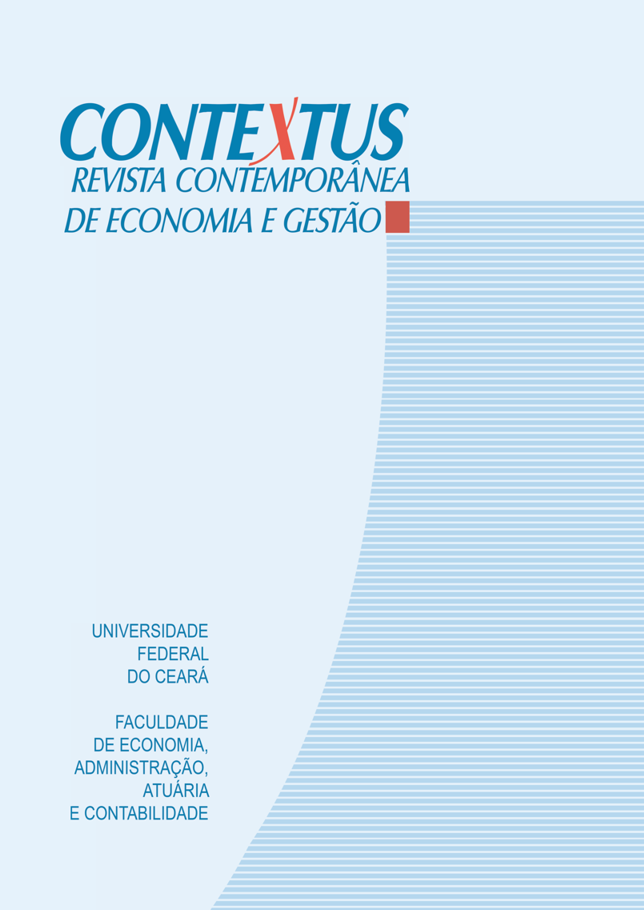Autonomía, multitarea y bienestar: Percepciones en teletrabajo
DOI:
https://doi.org/10.19094/contextus.2022.78275Palabras clave:
autonomía personal, comportamiento multitarea, bienestar en el trabajo, gestión de personas, teletrabajoResumen
El objetivo del estudio fue evaluar la percepción de trabajadores en relación a autonomía, control atencional para multitarea y bienestar. El abordaje es cuantitativo, descriptivo, encuesta, transversal. Técnicos administrativos en educación del Instituto Federal de Santa Catarina respondieron a los instrumentos. Se concluyó que existe una relación negativa entre el control atencional para la multitarea y el bienestar en el trabajo, que la dimensión motivación autónoma de la autonomía se relaciona con el bienestar y el control atencional para la multitarea se relaciona con la motivación autónoma. El estudio contribuye al avance de la comprensión de los problemas conductuales, cognitivos y emocionales en el contexto del teletrabajo.
Descargas
Citas
Aderaldo, I. L., Aderaldo, C. V. L., & Lima, A. C. (2017). Aspectos críticos do teletrabalho em uma companhia multinacional. Cadernos EBAPE.BR, 15(Edição Especial), 511-533. https://doi.org/10.1590/1679-395160287
Albuquerque, A. S., & Tróccoli, B. T. (2004). Desenvolvimento de uma escala de bem-estar subjetivo. Psicologia: Teoria e Pesquisa, 20(2), 153-164. https://doi.org/10.1590/S0102-37722004000200008
Bachmann, O., Grunschel, C., & Fries, S. (2019). Multitasking and feeling good? Autonomy of additional activities predicts affect. Journal of Happiness Studies, 20(2), 899-918. https://doi.org/10.1007/s10902-018-9973-3
Brown, T. A. (2015). Confirmatory factor analysis for applied research (Second edition). New York: The Guilford Press.
Cao, W., Fang, Z., Hou, G., Han, M., Xu, X., Dong, J., & Zheng, J. (2020). The psychological impact of the COVID-19 epidemic on college students in China. Psychiatry Research, 287, 112934. https://doi.org/10.1016/j.psychres.2020.112934
Charalampous, M., Grant, C. A., Tramontano, C., & Michailidis, E. (2018). Systematically reviewing remote e-workers’ well-being at work: a multidimensional approach. European Journal of Work and Organizational Psychology, 28(1), 51-73. https://doi.org/10.1080/1359432X.2018.1541886
Church, A. T., Katigbak, M. S., Locke, K. D., Zhang, H., Shen, Vargas-Flores, J. J., & Ching, C. M. (2012). Need satisfaction and well-being: testing self-determination theory in eight cultures. Journal of Cross-Cultural Psychology, 44(4), 507-534. https://doi.org/10.1177/0022022112466590
Cohen J. (1988). Statistical Power Analysis for the Behavioral Sciences. (2nd ed.). New York: Lawrence Erlbaum Associates.
Çokluk, Ö., & Koçak, D. (2016). Using Horn’s Parallel Analysis Method in Exploratory Factor Analysis for Determining the Number of Factors. Educational Sciences: Theory & Practice, 16(2), 537-551. https://doi.org/10.12738/estp.2016.2.0328
Corrêa, J. S., Lopes, L. F. D., Almeida, D. M., & Camargo, M. E. (2019). Bem-estar no trabalho e síndrome de burnout: Faces opostas no labor penitenciário. Revista de Administração Mackenzie, 20(3), 1-30. https://doi.org/10.1590/1678-6971/eRAMG190149
Cronbach, L. J. (1951). Coefficient alpha and the internal structure of tests. Psychometrika, 16(3), 297-334. https://doi.org/10.1007/BF02310555
Deci, E. L., Olafsen, A. H., & Ryan, R.M. (2017). Self-determination theory in work organizations: the state of a science. Annual Review of Organizational Psychology and Organizational Behavior, 4(1), 19-43. https://doi.org/10.1146/annurev-orgpsych-032516-113108
Diener, E. (1984). Subjective well-being. Psychological Bulletin, 95(3), 542-575. https://doi.org/10.1007/978-90-481-2350-6_2
Diener, E., Suh, E. M., Lucas, R. E., & Smith, H. L. (1999). Subjective well-being: Three decades of progress. Psychological Bulletin, 125(2), 276-302. https://doi.org/10.1037/0033-2909.125.2.276
Fabrigar, L. R., & Wegener, D. T. (2012). Exploratory factor analysis. Oxford: Oxford University Press.
Faul, F., Erdfelder, E., Buchner, A., & Lang, A.-G. (2009). Statistical power analyses using G*Power 3.1: Tests for correlation and regression analyses. Behavior Research Methods, 41(4), 1149-1160. https://doi.org/10.3758/BRM.41.4.1149
Faul, F., Erdfelder, E., Lang, A.-G., & Buchner, A. (2007). G*Power 3: A flexible statistical power analysis program for the social, behavioral, and biomedical sciences. Behavior Research Methods, 39(2), 175-191. https://doi.org/10.3758/BF03193146
Filardi, F., Castro, R. M. P., & Zanini, M. T. F. (2020). Vantagens e desvantagens do teletrabalho na administração pública: análise das experiências do Serpro e da Receita Federal. Cadernos EBAPE.BR, 18(1), 28-46. https://doi.org/10.1590/1679-395174605
Filgueiras, A., Galvão, B. O., Pires, P., Fioravanti-Bastos, A. C. M., Hora, G. P. R., Santana, C. M. T., & Landeira-Fernandez, J. (2015). Tradução e adaptação semântica do Questionário de Controle Atencional para o Contexto Brasileiro. Estudos de Psicologia, 32(2), 173-185. https://doi.org/10.1590/0103-166X2015000200003
Gnoatto, D. C. G. (2021). O efeito mediador do comprometimento sobre a relação entre estilos de liderança e bem-estar no trabalho (Dissertação de Mestrado). Universidade do Oeste de Santa Catarina, Chapecó, Santa Catarina, Brasil.
Gorsuch, R. L. (2015). Factor analysis (Classic edition). Hillsdale: Routledge, Taylor & Francis Group.
Hair, J. F., Jr., Hult, G. T. M., Ringle, C. M., & Sarstedt, M. (2014). A primer on partial least squares structural equation modeling (PLS-SEM). London: Sage.
Hayes, A. F. (2018). Introduction to mediation, moderation and conditional process analysis. (2nd ed.), New York: The Guilford Press.
Kang, H. (2021). Sample size determination and power analysis using the G*Power software. Journal of Educational Evaluation for Health Professions, 18(17). https://doi.org/10.3352/jeehp.2021.18.17
Kirchberg, D. M., Roe, R. A., & Van Eerde, W. (2015). Polychronicity and multitasking: A diary study at work. Human Performance, 28(2), 112-136. https://doi.org/10.1080/08959285.2014.976706
Landis, J. R., & Koch, G. G. (1977). The Measurement of Observer Agreement for Categorical Data. Biometrics, 33(1), 159-174. https://doi.org/10.2307/2529310
Lin, B. Y. J., Lin, Y. K., Lin, C. C., & Lin, T. T. (2011). Job autonomy, its predispositions and its relation to work outcomes in community health centers in Taiwan. Health Promotion International, 28(2), 166-177. https://doi.org/10.1093/heapro/dar091
Lizote, S. A; Teston, S. F., Régis, E. S. O., & Monteiro, W. L. S. (2021). Tempos de pandemia: bem-estar subjetivo e autonomia em home office. Revista Gestão Organizacional, 14(1), 342-362. https://doi.org/10.22277/rgo.v14i1.5735
Lopes, F. T. (2020). Janelas da Pandemia. Belo Horizonte: Editora Instituto DH.
Martins, A. M. (2002). Autonomia e educação: A trajetória de um conceito. Cadernos de Pesquisa, 115, 207-232. https://doi.org/10.1590/S0100-15742002000100009
Mendes, R. A. O., Oliveira, L. C. D., & Veiga, A. G. B. (2020). A viabilidade do teletrabalho na administração pública brasileira. Brazilian Journal of Development, 6(3), 12745-12759. https://doi.org/10.34117/bjdv6n3-222
Michaelis (2021). Dicionário Brasileiro da Língua Portuguesa Michaelis (2021). https://michaelis.uol.com.br/moderno-portugues/busca/portugues-brasileiro/autonomia/
Mourão Jr., C. A., & Melo, L. B. R. (2011). Integração de três conceitos: função executiva, memória de trabalho e aprendizado. Psicologia: Teoria e Pesquisa, 27(3), 309-314. https://doi.org/10.1590/S0102-37722011000300006
Offer, S., & Schneider, B. (2011). Revisiting the gender gap in time-use patterns. American Sociological Review, 76(6), 809-833. https://doi.org/10.1177%2F0003122411425170
Paschoal, T., Silva, P. M., Demo, G., Fogaça, N., & Ferreira, M. C. (2022). Qualidade de vida no teletrabalho, redesenho do trabalho e bem-estar no trabalho de professores de ensino público no Distrito Federal. Contextus – Revista Contemporânea De Economia e Gestão, 20(2), 1-12. https://doi.org/10.19094/contextus.2022.70500
Paschoal, T., & Tamayo, A. (2008). Construção e validação da escala de bem-estar no trabalho. Avaliação Psicológica, 7(1), 11-22.
Podsakoff, P. M., MacKenzie, S. B., Lee, J.-Y., & Podsakoff, N. P. (2003). Common method biases in behavioral research: A critical review of the literature and recommended remedies. Journal of Applied Psychology, 88(5), 879-903. https://doi.apa.org/doi/10.1037/0021-9010.88.5.879
Posner, M. I. (1980). Orienting of Attention. The Quarterly Journal of Experimental Psychology, 32(1), 3-25. https://doi.org/10.1080/00335558008248231
Prasad, K., Mangipudi, M. R., Vaidya, R. W., & Muralidhar, B. (2020). Effect of occupational stress and remote working on psychological well-being of employees: an empirical analysis during covid-19 pandemic concerning information technology industry in Hyderabad. International Journal of Advanced Research in Engineering and Technology (IJARET), 11(4), 372-389. https://doi.org/10.18843/ijcms/v11i2/01
Proctor, C. (2014). Subjective well-being (SWB). Encyclopedia of Quality of Life and Well-Being Research, 6437–6441.
R Core Team (2021). R: A Language and environment for statistical computing. (Version 4.0) [Computer software]. https://cran.r-project.org
Reis, H. T., Sheldon, K. M., Gable, S. L., Roscoe, J., & Ryan, R. M. (2000). Daily well-being: the role of autonomy, competence, and relatedness. Personality and Social Psychology Bulletin, 26(4), 419-435. https://doi.org/10.1177/0146167200266002
Resolução nº 510, de 07 de abril de 2016 (2016). http://conselho.saude.gov.br/resolucoes/2016/Reso510.pdf
Revelle, W. R. (Photographer). (2017). Psych: Procedures for Personality and Psychological Research. Software
Rosenfield, C. L., & Alves, D. A. (2011). Autonomia e trabalho informacional: o teletrabalho. Dados, 54(1), 207-233. https://doi.org/10.1590/S0011-52582011000100006
Salvucci, D. D., & Taatgen, N. A. (2008). Threaded cognition: an integrated theory of concurrent multitasking. Psychological Review, 115(1), 101-130. https://doi.org/10.1037/0033-295X.115.1.101
Salvucci, D. D., & Taatgen, N. A. (2011). The multitasking mind. Oxford: Oxford University Press.
Sharma, R., Yetton, P., & Crawford, J. (2009). Estimating the effect of common method variance: The method-method pair technique with an illustration form TAM research. MIS Quarterly, 33(3), 473-490. https://doi.org/10.2307/20650305
Sheldon, K. M., Turban, D. B., Brown, K. G., Barrick, M. R., & Judge, T. A. (2003). Applying self-determination theory to organizational research. Research in Personnel and Human Resources Management, 22, 357-393. https://doi.org/10.1016/S0742-7301(03)22008-9
Shih, S. I. (2013). A null relationship between media multitasking and well-being. PLoS ONE, 8(5), e64508.
Siqueira, M. M. M., & Padovam, V. A. R. (2008). Bases teóricas de bem-estar subjetivo, bem-estar psicológico e bem-estar no trabalho. Psicologia: Teoria e Pesquisa, 24(2), 201-209. https://doi.org/10.1590/S0102-37722008000200010
Slemp, G. R., Kern, M. L., Patrick, K. J., & Ryan, R. M. (2018). Leader autonomy support in the workplace: a meta-analytic review. Motivation and Emotion, 42, 706-724. https://doi.org/10.1007/s11031-018-9698-y
Steiger, J. H. (1990). Structural Model Evaluation and Modification: An Interval Estimation Approach. Multivariate Behavioral Research, 25(2), 173-180. https://doi.org/10.1207/s15327906mbr2502_4
The jamovi project (2021). jamovi. (Version 1.8) [Computer Software]. https://www.jamovi.org
Theurer, C. P., Tumasjan, A., & Welpe, I. M. (2018). Contextual work design and employee innovative work behavior: when does autonomy matter?. PLOS ONE, 13(10). https://doi.org/10.1371/journal.pone.0204089
Tucker, L. R., & Lewis, C. (1973). A reliability coefficient for maximum likelihood factor analysis. Psychometrika, 38(1), 1-10. https://doi.org/10.1007/BF02291170
Van Horn, J. E., Taris, T. W., Schaufeli, W. B., & Schreurs, P. J. G. (2004). The structure of occupational well-being: A study among Dutch teachers. Journal of Occupational and Organizational Psychology, 77(3), 365-375. https://doi.org/10.1348/0963179041752718
Xu, S., Wang, Z. (Joyce), & David, P. (2016). Media multitasking and well-being of university students. Computers in Human Behavior, 55, 242-250. https://doi.org/10.1016/j.chb.2015.08.040
Zhou, Q., Li, Q., & Gong, S. (2019). How job autonomy promotes employee’s sustainable development? A moderated mediation model. Sustainability, 11(22), 6445. https://doi.org/10.3390/su11226445
Descargas
Publicado
Cómo citar
Número
Sección
Licencia
The authors, while doing the submission, accept the notice below:
We authors hold the copyright related to our paper and transfer Contextus journal the right for the first publication with a Creative Commons’ international license of the modality Attribution – Non-commercial 4.0, which in turn allows the paper to be shared providing that both the authorship and the journal’s right for initial release are acknowledged.
Furthermore, we are aware of our permission to take part in additional contracts independently for non-exclusive distribution of the version of our work published in this journal (e.g. publishing it in an institutional repository or as a book chapter), while acknowledging both the authorship and the journal’s initial publication.
We also certify that the paper is original and up to this date has not been released in any other journal, Brazilian or of another nationality, either in Portuguese or another language, as well as it has not been sent for simultaneous publication in other journals.
Last, we not only know that plagiarism is not tolerated by Contextus but also certify the paper presents the sources of passages from cited works, including those authored by ourselves.









3.png)


1.jpg)



1.jpg)


1.jpg)






.jpg)



1.jpg)

1.jpg)


1.jpg)

1.jpg)
1.jpg)
2.png)




1.jpg)
2.jpg)

1.jpg)





1.jpg)


1.jpg)
1.jpg)
